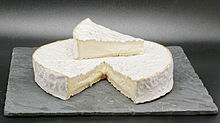Brie (cheese)
Brie is the name of a soft cheese with white noble mold that originally comes from the region of the same name in France and is made from raw or pasteurized cow's milk.
history
The Brie has its origins in the Seine-et-Marne department in Île-de-France ; Today, however, it is one of the most copied cheeses in the world, and there are only two types left that enjoy protection of origin in France , the Brie de Meaux and the Brie de Melun ( AOC since 1980). The Brie de Meaux has been documented since the 13th century and was praised as the best cheese in France in a list of French specialties in 1470 by the Piedmontese doctor Pantaleone da Confienza. The Brie was named “King of all cheeses” at the Congress of Vienna , when the French statesman Talleyrand organized a cheese competition to loosen up the negotiations on the political reorganization of Europe, in which all thirty national representatives presented their local cheeses. With the construction of rail and canal connections to Paris, a milk processing industry was able to develop in the Meuse in Lorraine . The first establishment took place in 1853 with the company Maison-du-Val in Noyers-en-Barrois ( Noyers-Auzécourt ), by Louis Bailleux, a farmer and innkeeper from Hazebrouck. In 1872 the factory was already processing 40,000 hectoliters of milk from around 2000 farmers in the environment. In the 1920s, the company had 5,000 cubic meters of cold storage space to store 200,000 kg of freshly made cheese.
Manufacturing
In the production of the classic Brie, the jelly is neither cut nor pressed. The art of production consists in scooping the curds evenly into the perforated molds and in optimally draining the whey. If this is not done carefully, a dry, chalky and gypsum-like cheese can easily result. After molding, the loaves are placed on straw or plastic mats and turned regularly. After about a week, the cheeses are sprayed with a mold culture (usually Penicillium candidum , more rarely Penicillium camemberti ) and stored under carefully controlled temperature with further turning until they have ripened, which can take between three and ten weeks.
properties
The Brie de Meaux loaves are shaped like a flat cake and weigh between 900 g and 3.2 kg. They have a diameter of 35 to 37 cm and a height of about 2.5 cm. Brie de Meaux is covered in dense white mold and a light reddish-brown cheese flora, which distinguishes it from many copies. The dough is initially white to straw-colored and later ivory-colored to yellow and at the height of its ripening it is creamy-soft without completely flowing out. It smells of spicy grass and roasted nuts, ripe to overripe, increasingly of ammonia . The taste is mild to fruity-spicy, with raw milk broth from farm production tasting stronger and nuttier than the mostly pasteurized factory cheese.
The likewise pie-shaped Brie de Melun is smaller in diameter and matures longer than the Brie de Meaux. It has a golden yellow paste and a reddish brown cheese flora, which is interspersed with white mold spots, and tastes and smells stronger than its relative.
use
Brie is a classic cheese for a mixed cheese platter , but can also be used in warm cooking as it melts well in soups and sauces after the crust is removed. It goes well cold with mustard sauce and salad, but also accompanies potato dishes and stewed vegetables when sliced. A Chardonnay or a dessert wine can be used as an accompanying drink .
Brie Obatzter is made as a Bavarian specialty . To do this, it is mixed with butter , cream , chopped onions , caraway seeds and paprika powder .
Web links
Individual evidence
- ↑ a b Lorraine: Produits du terroir et recettes traditionalnelles . In: Claude Lebey (ed.): L'inventaire du patrimoine culinaire de la France . Editions Albin Michel, Paris 1998, ISBN 2-226-10003-2 , pp. 187 ff .
- ^ Lentz, Thierry: 1815: the Congress of Vienna and the re-establishment of Europe . 1st edition. Siedler, Munich 2014, ISBN 978-3-8275-0027-4 , pp. 164 .
- ↑ a b Brie. In: All about cheese. August 15, 2017, accessed on April 15, 2020 (German).
- ↑ How To Eat Brie Just Like The French Do. In: Président®. February 20, 2018, accessed April 15, 2020 (American English).


